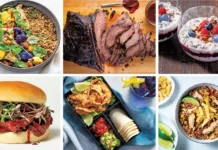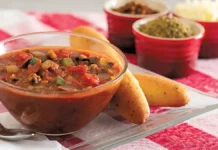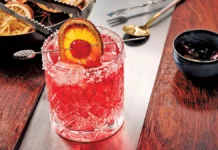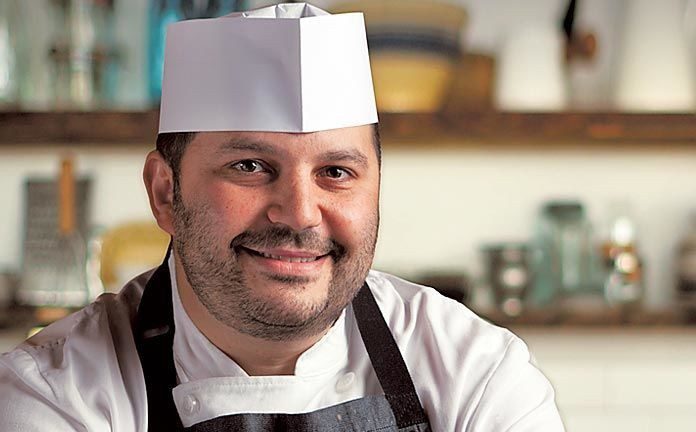
Josh Laurano has established himself as one of Metro New York’s hottest young toques. The Manhattan based chef’s career has been guided by the celebrated Chef Mario Batali. As part of the B&B Hospitality team, Laurano has held a number of posts at several of the firm’s properties.
For the first time in Josh Laurano’s career, he can now call Chef Batali his partner as Laurano looks to establish La Sirena as one of the city’s top eateries. Total Food Service sat down with Josh Laurano to discuss his inspirations, aspirations, and everything in-between.
How did you get into the culinary business?
I grew up in a food family. My father owned a vegetarian restaurant in New Jersey before vegetarian restaurants were fashionable. My mother was an organic baker. She’s the knish queen of West Virginia! They were kind of like hippies, who were geared around food. Also, my uncle owned a dinette in South Jersey that did early morning breakfast. And summers, I would work at these restaurants, or work with my mom. But like anybody else, as soon as I got out of the house, I wanted to get as far away as possible. So after college, I ended up going into the art business.
And what made you decide to do that?
Actually, I wasn’t studying art then either. I’d spent some time doing post-graduate travel around Europe and I came back and I needed a job. I was lucky enough to get a job working for a fine art company located in Greenwich. I didn’t know anything about art at the time. But I loved it. So I studied and learned and worked my way up with my business and my art background. Unfortunately the company ended up moving to LA so I was out of a job. I’d been in a successful art business but I knew that that wasn’t a long-term play for me. So I started bartending in Manhattan and I was reintroduced into the culture of restaurants and bars and got reinvigorated.
Then what happened?
I said, this is it. Now I know what I want to do. I want to be a chef. And I want to get back in the kitchen. I was immediately drawn back to the pace.
So how did you get back in the business?
I started learning as much as I could. So I went to work for a butcher in the Village. I worked for a pork store in North Jersey. I went to Lupa and started hanging out and working for free just because I wanted to immerse myself in it as much as possible. Then I went to the Institute of Culinary Education (ICE).
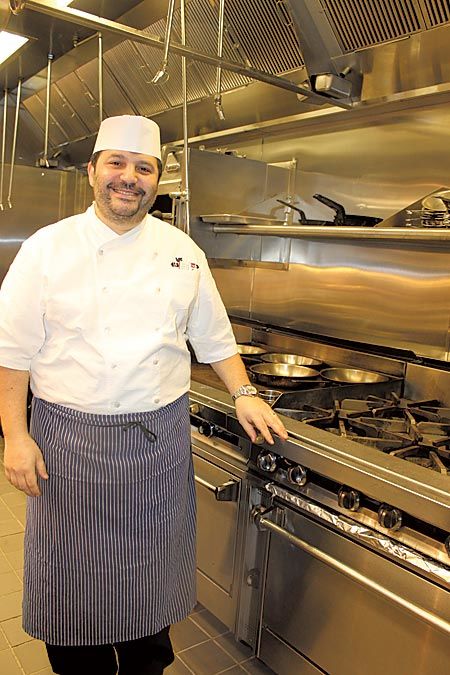 Tell me about your experience at I.C.E.
Tell me about your experience at I.C.E.
Culinary school, like any other school or trade school, helps get you in the right direction. So you can get as much out of it as you want, but you have to put the effort in. You’ve got to put the work in, you have to read, you have to study, you have to practice. Culinary school gave me the framework of where you find the tools to be successful. Here’s your platform. And then I think from there it’s up to the person’s motivation to figure it out.
What was the best part of it?
You’re working with people who have real practical life experience in kitchens, who say, dude, if you did that in my kitchen, you’d be fired.
So what happened after ICE?
You do an externship when you’re done with your schoolwork and they set you up with your first culinary job post-school. My favorite restaurant at the time was Lupa. I had already spent some time there. I was impressed with the work that Mark Ladner and his staff were putting out. I went there and worked my butt off. I worked every station for 3 ½ years.
What did you take away from it?
I learned that food doesn’t necessarily have to be fancy to be delicious. And that sometimes the most yummy food comes from a long, storied cultural past. Playing with the framework of Roman cuisine by using the best of Hudson Valley to me was really exciting and it taught me that the most important thing you can do is find the best product that’s local, that’s delicious, and then try and work within some parameters. This concept of farm-to-table is how you eat every day of the year in Italy and so you don’t eat tomatoes when they’re not around.
What’s your biggest goal, as a chef?
That it’s delicious, that it’s fresh. I want to come up with really creative and excellent ways to eat the food.
What led you to Del Posto?
Working for Mario Batali was an honor. And I learned a lot from him about understanding that the most important thing we can take away from our time in the kitchen is that it’s never about the chefs, and it’s never about the sommelier, or about the bartender, it’s about the customer. Also, finding out a way to have them leave happier than when they came in and to come out of it with a great experience. So when they opened Del Posto, I was happy. I was lucky enough to have an opportunity to move there from Lupa.
How did you personalize your experience?
It’s important to not skip the steps. When I come and I work, I want to work every station. I want to work the salad station. I want to work with the grill station. I want to see the evolution of the dining experience. I want to see all the recipes. You learn the chef. You learn the culture. You learn that it’s one thing to do it every day. You start to respect the people who are the building blocks of these restaurants. The butcher that’s been there ten years, the dish washer that’s been there since he was 17. You learn to understand the intricacies of what makes great restaurants great.
What are the things that you’ve seen that make great restaurants great?
I have a saying to my cooks — you’re only as good as your first and last dish. Great restaurants put out great product all the time. They don’t have bad nights, and when they do, they find ways to fix them. They’re not necessarily the hottest restaurants today, or the trendiest, but they’re the restaurants that stay around. And they’re the right restaurants for the right occasion.
Then you went on to Tarry Market in Port Chester.
I was the a.m. sous chef for another three years. It was great to see a really, really busy restaurant, and a really small kitchen. I then went back to the City to become the sous chef at Babbo.You get beat up a little bit in that kitchen! You learn your job, you understand what it takes to make it.
Are there any life lessons you’ve learned from your culinary experience?
I try to be the first one in and the last one to leave. I try to always dedicate myself to focusing on doing whatever I’m doing as well as possible. For example, I’m having a hard time getting these beans to come out the way I want them to. I start reading about why the beans aren’t cooking properly, what other cooking techniques I should do. So it’s part trial and error. But you’ve got to put the time in, both in the kitchen and outside the kitchen.
What was your retail experience like? How is it different?
You get to see how people react to food. In most worlds a lot of chefs like being behind the scenes, not necessarily the most comfortable talking in groups or talking to people. But this was a good experience, it forced me to be a little bit out of my comfort zone. Any time you’re doing something that you’re uncomfortable with, I feel like you’re learning. Dealing with retail is very different. Somebody orders this really expensive steak, and you’re trying to walk them through the process of cooking it. It’s somewhat challenging. We see retail and large grocers trying to get into the home meal replacement business and in many cases, restaurants actually do this in their operations.
Do you see that happening a lot?
Some people are not the best cooks. But they can use these meal replacements and they enjoy it because it gives you a very structured sense of what you’re doing. I get a box and everything’s in there. There’s really clear instructions. It makes a big difference. Somebody who cooks and likes to cook, who likes to be creative and play with ingredients and not necessarily be so rigid, wouldn’t necessarily appreciate that.
What about La Sirena?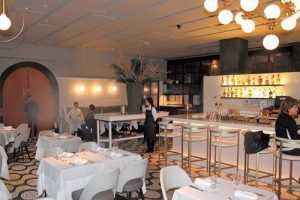
I had the opportunity to come in as a partner. This is the first venture where I have some skin in the game. So it was definitely a learning curve for me, a different experience both emotionally and physically. I think that has its challenges in size and scope. We have 400 seats on the patio. Working in this area with this beautiful hotel, and being able to put out what we think is a great product for a really large amount of people at a time was very alluring to me. It’s a much different dining experience. That definitely “destination, kind of an anniversary” dining experience geared towards location. We’re open for breakfast, lunch, and dinner. We do room service, we have banquets. So there are a lot of moving parts. We have tried to blend the food to make it both approachable and interesting.
So it’s location, location, location?
We’re right across from Chelsea Market. We’re lucky enough to be in the storied Maritime Hotel. This is an area that definitely has a very vibrant nightlife scene. It’s not the same kind of Sunday afternoon dining experience that you would get in the West Village or Greenwich Village. People are coming out here for a good time, which we are happy to accommodate.
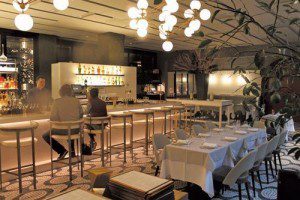 What about in terms of creating the menu at La Sirena? As you looked at what you were trying to accomplish, talk a little bit about how you approached it.
What about in terms of creating the menu at La Sirena? As you looked at what you were trying to accomplish, talk a little bit about how you approached it.
Mario Batali has a number of ideas. I had some ideas. It was definitely a collaborative effort. We sat down. We extensively tasted it, went through these dishes. We pulled some of the best from Italy and locally. But it was definitely a long process. We were in development for six to eight months for sure. I went to Rome right before and then I recently spent some time down by Santa Margarita and Port Santa Margarita. We played around with some Spanish ingredients, and we used a lot of local ingredients. That part to me is really exciting.
What about building your team?
We really try and focus on bringing people from within the B&B hospitality family up through the ranks. Every now and then we pull someone in from outside but in this kind of changing climate, as it pertains to the new labor laws, for us it’s more important to get as many good, young cooks around us as possible. We want to help them as cooks develop their style and then mentor them through the management process.
What about working with vendors?
It’s important to develop relationships with vendors. I probably use less vendors than other restaurants, but I know that I’m going to get first pick sometimes. They’re loyal, and so we work with a couple of farm-to-table collaborative organizations that bring produce and or dairy, eggs, etc., from the Hudson Valley direct to our doorstep. We’re in the business of doing the best for our customers.
To learn more about Josh Laurano and La Sirena, visit the website.



















